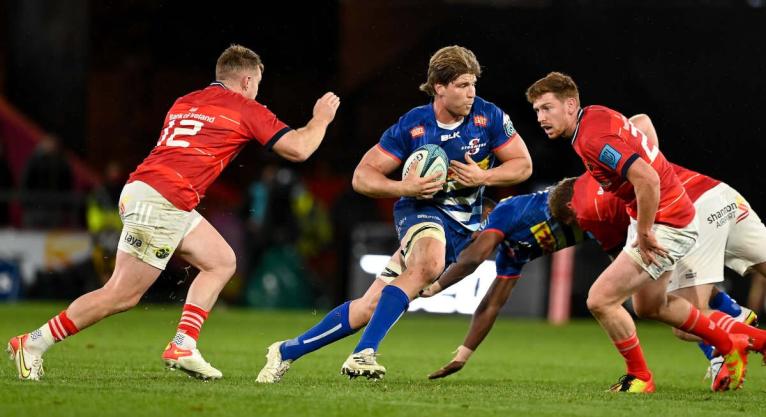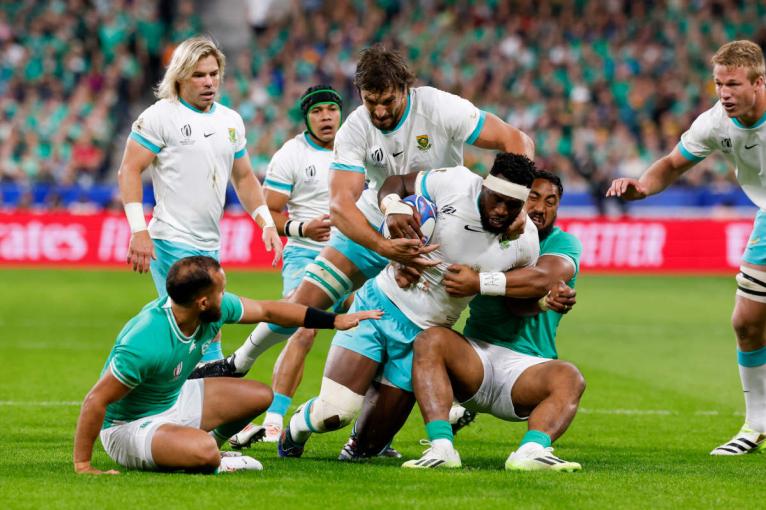It is the first time that it has happened in the history of the Rugby World Cup. Nations from north of the equator won all four of their group matches, with France, Ireland, Wales and England emerging from pool play with a 4-0 record and a clean sweep of their opponents from the south.
That is enough to give any rugby supporter pause for thought looking forward to the future of the game. It is probably only a matter of time before the Springboks join the premier blue-chip international tournament in the Northern Hemisphere. South Africa’s withdrawal from the Rugby Championship, and entry into the Six Nations will complete its move across rugby’s equivalent of the Berlin Wall.
Their ex-Super Rugby franchises are all comfortably ensconced in the United Rugby Championship, and more latterly, in the Champions Cup and Challenge Cup competitions, which contain clubs from eight different nations.
As the chief executive of the URC, Martin Anayi, explained at the beginning of the year, South Africa’s arrival has signaled that Europe has moved beyond its own geographical boundaries. It has added new depth and minted fresh rivalries:
“It is no longer European – this is about Champions’ Cup rugby, pitting the best teams against the best and we are getting that. There is nobody in this world that can tell me the big four South African franchises don’t deserve their spot at the table.”

European rugby is now about far more than Europe, and the new rivalry between Ireland, France and South Africa especially, adds a special edge to competition at all levels, both national and international.
It has also stripped bare the relative imbalance in Super Rugby Pacific, with nobody able to interrupt a predictable Kiwi victory procession. New Zealand will not weaken its domestic product to accommodate Australia, and Australia cannot strengthen its flimsy five-team format to compete with its trans-Tasman foes. It is a vicious circle indeed.
Strengths and weaknesses at the level below international rugby have translated straightforwardly to results at the Rugby World Cup thus far. France beat New Zealand, Wales routed the hapless Wallabies, and 14-man England turned over Argentina with something to spare. The nation which has come closest to bucking the trend thus far is South Africa, whose players now all ply their trade in northern competitions.
One of the major concerns for the Rugby Championship representatives is their inability to unlock the blanket defensive patterns of the top Six Nations teams. They only scored three tries in the four big matches which were supposed to decide the winners of each pool, and that is an unexpected new development.
New Zealand scored 240 points against the minor teams in their group, but they never threatened to cut loose against Les Bleus in the period where they have traditionally dominated, the final quarter. It was France who scored the last 13 points of the game, while conceding none.
You saw a different spectacle tonight and at some point, the world has got to decide which game it would rather watch.
All Blacks coach Ian Foster
That provided the motivation for head coach Ian Foster’s comments after the All Blacks 96-17 demolition of Italy. ‘Fozzy’ could scarcely conceal his irritation at how things have been playing out:
“In rugby, you have to deal with the challenges that you’ve got. The trouble is if you win with a big scoreline, people believe there is no value in it. The value has been massive for us as we put ourselves under pressure the last 10 days for that performance…
“If you look at the South Africa-Ireland game, it was a different game of rugby. The ball was in play for 27 minutes throughout the whole game. It was a very stop-start game, very physical, very combative.
“You saw a different spectacle tonight and at some point, the world has got to decide which game it would rather watch.”
In fact, the ball-in-play times for the South Africa-Ireland match (30’) and Italy-New Zealand (32’) were similar. What was different was the massive uplift in defensive intensity on both sides, in Pool B’s version of Le Crunch, and that is really the source of Foster’s ire.

The idea that New Zealand wants more ball-in-play time is a red herring and it misrepresents the shifts in the north over the last World Cup cycle. The average ball-in-play time at the 2022 Rugby Championship was 31-and-a-half minutes, and it had improved by four minutes (to 35-and-a-half) one year later. But that figure still languishes behind the 2023 Six Nations, at an overall average of just over 38 minutes per game.
Matches involving Grand Slam winners Ireland came in even higher, at 39-and-a-half minutes per game, and the coruscating finale between Ireland and France played out in Dublin featured a colossal 46 minutes of ball-in-play time. The idea that New Zealand is seeking a faster or more fluid game than anyone else is a misconception, hiding in plain sight. In truth, the game in the south has been playing catch-up in that area for the past two or three seasons.
The game between a Dupont-less France and the same opponents that the All Blacks overwhelmed by almost 100 points also featured two-and-a-half more minutes of ball-in-play time than Italy versus New Zealand. The two teams combined for 255 carries and 1,600 metres in a game with a higher ratio of LQB (sub-three second ruck ball), and all those figures compare favourably to the match last week.
In my previous piece, I examined how New Zealand teams like to defend in the wider channels of the field. The game between France and Italy provided some instructive examples of the advances made in Europe, on both sides of the ball.
The game went off like a firecracker. France passed the 40-ruck threshold by the end of the first quarter, and they scored three tries in that period. Their first attacking sequence lasted for one minute and 20 seconds:

After a strong drive off the base by Charles Ollivon, you will often see the offensive picture presented in the screenshot among many of the elite sides in the Northern Hemisphere. The idea could be called a ‘Power I’ formation and was originally borrowed from a similar offensive run formation common in American Football.
There are three men in the ‘I’, one behind the other – a forward (No 4 Cameron Woki) up top, with the main receiver (#No 10 Matthieu Jalibert) directly underneath him and a third striker (fullback Thomas Ramos) tucked in behind the French first five-eighth. The formation gives maximum flexibility for the attack and creates the most problems in decision-making for the defence. The attackers can pass short or long, and they have enough time to change their angle of run if they choose to keep the ball.
In this case, Jalibert and Ramos uncoil from the ‘I’ to create a chance for their two wings, Damian Penaud and Louis Bielle-Biarrey, in space down the left five-metre corridor. At the start of the second period, Jalibert shaped his run to take advantage of the space on the inside instead:
It is the same ‘I’ formation with Jalibert receiving the ball behind from Ollivon, but on this occasion Italy No 13 Ignacio Brex has over-committed to the outside and that leaves an inviting hole for the cutback run by the quicksilver Union Bordeaux-Bègles No 10.
The rush defence coached by France maestro Shaun Edwards has evolved to cope with such strategies. The New Zealand pattern of defence usually features halfback Aaron Smith organising the D from the ‘boot-space’ directly behind the ruck. In the French version, the same defender is used as an extra body further out in the line:

In both clips, the wide positioning of France halfback Maxime Lucu enables him to cover both the second and third options in the ‘I’ formation, and create jackaling opportunities for first No 12 Jonathan Danty and then No 7 Antony Jelonch. This element of the French defence is typically even more powerful and decisive with Antoine Dupont in at scrumhalf for Lucu.
The attitude of the French outside centre and wings is also very different to their counterparts in the All Blacks:

In the first clip, Bielle-Biarrey (in the red hat) moves upfield, squaring in directly on the passer – he is not concerned about his opposite number, rather he is threatening the passing lane and forcing the play back inside, straight into the clutches of predatory No 8 Greg Alldritt.
In the second example, it is centre Gael Fickou playing the same role, squaring up to the passer with his back to the touch-line, and giving Alldritt another big crack at the ball after the tackle is completed.
In the golden era between the two World Cups in 2011 and 2015, the All Blacks owned the supreme poker-face in world rugby. On the rare occasions when they were hurting, the damage was repaired before you knew it had even been inflicted. They knew they were the best, they knew they were ahead of the curve in innovation and they had the answer to every problem.
The waters have muddied since then. New Zealand is out on its own and it does not encounter any significant resistance at Super Rugby level. Meanwhile, European rugby has expanded and improved, as the rivalries between South Africa, France and Ireland at all levels push each to new levels of excellence.
No wonder Ian Foster looked so twitchy when he went ‘all-in’ on his bluff about the stop-start nature of rugby in the north. Even his skipper Ardie Savea, sitting alongside him at the presser, raised his eyebrows in alarm.
The stats tell a very different story to the one narrated by the Kiwi head coach. Ball-in-play times are consistently higher up north than they are in the south, and the notion that the All Blacks are trying to play a faster, more fluid and dynamic game than everyone else is sadly outdated.
It was certainly true once upon a time but it is not true anymore. That is where New Zealand rugby stands right now, after the opening night in Paris – on the precipice of a great unknown. Will even its best rugby, played on its best day, be enough to topple the likes of Ireland, or France or the Springboks?



Comments
Join free and tell us what you really think!
Sign up for free